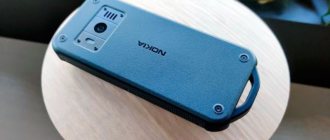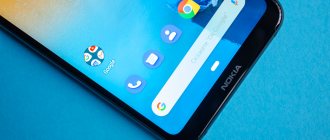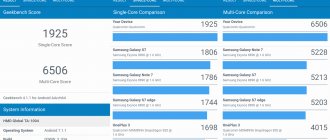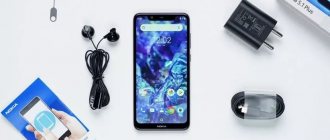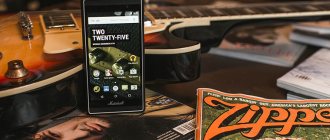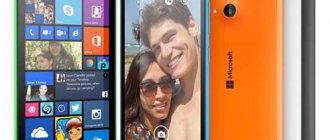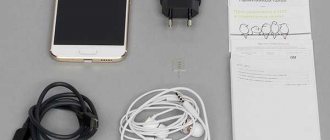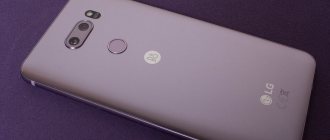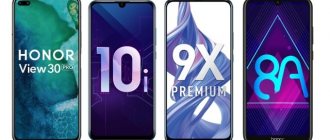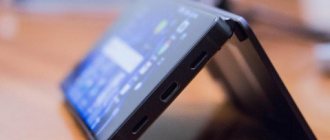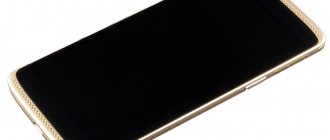Nokia 6 specifications:
- Qualcomm Snapdragon 430 processor (model MSM8937) 8 Cortex-A53 cores, up to 1.1 GHz (20 nm, 64-bit)
- Adreno 505 graphics
- RAM 4 GB LPDD3 (after reboot free around 2300 MB)
- 64 GB data storage (52 GB available out of the box)
- Supports Micro SD memory cards up to 256 GB
- 5.5" IPS LCD display with 1920 x 1080 resolution, no air gap
- 8 MP front camera (f/2.0 aperture, one 1.12 micron pixel, 1080p video recording / 30 fps)
- main camera 16 MP (f/2.0 aperture, one 1.0 micron pixel, dual-tone LED flash, 1080p video recording / 30 fps, HDR)
- 3000 mAh battery (no fast charging, 5V/2A)
- OS Android 7.0
- own shell
- Dolby Atmos support, TFA9891 amplifier
- Sensors: accelerometer, light and distance sensor, gyroscope, electronic compass, fingerprint scanner
- Connectors: Micro USB (OTG works), 3.5 mm audio output
- dimensions: 154 x 75.8 x 7.9 mm
- weight 169 grams
⇡#Camera
But the camera in Nokia 6 is surprisingly good for a smartphone in this class. This is a 16-megapixel module with an ƒ/2.0 aperture lens - without a fancy second sensor, but the only one that is there has standard dimensions (1/3.06″, pixel size - 1 micron) and the software works well with it.
He is friendly precisely when it comes to the quality of the pictures. The smartphone produces a very pleasant JPEG with good, that is, natural and moderately bright, color reproduction and a decent dynamic range. What’s most curious is that the Nokia 6 takes good pictures in low light – despite the fact that there is no optical stabilizer. The smartphone keeps the shutter speed on automatic within the limits of decency, it is quite easy to get an unblurred photo, and the light sensitivity is enough for the image to retain relatively good detail - at least on the smartphone screen. When viewed on a monitor, of course, it is noticeable that these are just “smartphone” photographs. Well, we must not overdo it with the “lack of” lighting - this is still not the Samsung Galaxy S8 or Huawei P10.
| Nokia 6 camera app interface | ||
The disadvantages of the Nokia 6 camera are in the application. It is very, if I may say so, tight - it opens slowly, saves pictures for a long time, the camera also focuses with difficulty, and sometimes refuses to do so (you have to redo the same frame several times). The interface is also not great - it is quite simple, but to enable manual mode, for example, you have to make a couple of extra movements.
Nokia 6: photo gallery
View all images (27)
The camera can record video in Full HD resolution.
The front camera has a matrix with a resolution of 8 megapixels and a lens with an aperture of ƒ/2.0 – again, very good for a smartphone in the mid-price range. There is no autofocus or flash. But like, for example, LeRee Le 3, the smartphone does not blur; the focus is set to a normal distance. In normal light, selfies turn out quite well; in low light, details are, of course, lost - everything is as usual.
Nokia 6 equipment
Nokia 6 is delivered in a spacious cardboard package, on the front side of which we see a picture in the form of closed hands and a corporate logo. The box turned out to be not only stylish, but also durable, which protects the phone from damage during delivery from Aliexpress and other Chinese stores.
While compiling a review of Nokia 6 in Russian, we found the following equipment:
- microUSB cable;
- Charger with parameters 5V, 2A;
- Wired headphones;
- Paper clip and documentation.
The Nokia 6 smartphone was presented with dignity; when you open the packaging, you see in front of you many bags in which all the accessories are individually packaged. This approach is undoubtedly encouraging.
Nokia 6 review: software features
The Nokia 6 smartphone runs on the latest version of the Android 7.1.1 (Nougat) operating system without shell and unnecessary add-ons. This allows you to quickly receive the latest updates to the “green robot”.
As in Nokia 3, after activating the options in the “Movements” section, you can reject the call simply by turning the smartphone over, and to reduce the signal volume you need to take the device in your hand. In addition, in the Gestures section there is an option for quick access to the camera, called by double-pressing the lock power button.
To unlock your smartphone using a fingerprint scanner, you can use up to 5 fingerprints.
Design
Nokia 6 smartphone review considers the design to be one of the positive aspects of the device; it turned out to be quite attractive and unusual. The body is all metal, there are only small plastic inserts for the antennas, which are very difficult to see. The metal has a matte surface, and the rough finish prevents the device from slipping in the hand and collecting fingerprints. The tactile material is very pleasant; you immediately get the impression of a truly expensive and premium device.
The camera module protrudes slightly outside the body, so you need to use the smartphone carefully so as not to accidentally damage it. We were unable to find out anything about what kind of glass the Nokia 6 camera module is covered with. But if it is not sapphire crystal, then you can soon expect scratches to appear on the camera.
The Nokia 6 display is covered with tempered Gorilla Glass 3, made using 2.5D technology. The coating reliably protects against impacts and scratches. Below we see three backlit touch navigation keys. But the manufacturer went for a rather unusual solution, which you begin to get used to over time - the return key is provided on the left, and the task manager on the right. In the center is the Home button with a fingerprint scanner built into it. It reads fingerprints well, but is inferior in speed to many competitors.
Above the display we see the corporate logo, front camera, speaker and notification light.
As the Nokia 6 black mobile review shows, the ends are also made of metal. In general, the smartphone has a very nice appearance and an ergonomic shape that allows you to comfortably use it even with one hand.
On the left, according to tradition, there is a hybrid tray for 2 Nano and microSIM format SIM cards or one SIM card and a flash drive with a capacity of up to 128 GB.
On the right is the volume rocker and the power control key. The buttons have a smooth operation and good feedback.
At the bottom of the Nokia 6 we see a microphone, a multimedia speaker grille, and microUSB 2.0 between them.
At the top is a headset jack.
The body is assembled with high quality, once you pick up the device, you immediately get the impression of a real flagship device with a bright and memorable appearance, different from most of the same type of competitors.
Nokia 6 review: design, ergonomics
One of the distinguishing features of premium Nokia feature phones is undoubtedly the metal body. However, not only more affordable devices with mechanical keyboards were content with plastic. For example, for the Nokia X Android family mentioned above, polycarbonate was also chosen as the body material. And the youngest model in the new line, Nokia 3, has only a metal frame. But the Nokia 6 smartphone already boasts an all-metal body. To produce it, as if following the precepts of the brilliant O. Rodin, a block (more precisely, a blank) is taken from a 6000 series aluminum alloy and all unnecessary is cut off from it by milling within 55 minutes. Overall dimensions at the finish are 154x75.8x7.85 mm, however, taking into account the protruding photo module of the main camera, the total thickness increases to 8.4 mm. As a result, the weight of this “iron” smartphone does not exceed 169 g. Similar parameters for the 5.5-inch “classmates” Huawei Honor 6X and Xiaomi Redmi Note 4, announced last year, are 162 g and 165 g. At the same time, the thickness devices – 8.2 mm and 8.45 mm, respectively.
The ends and edges of the Nokia 6 body seem sharper than they actually are, since all their edges are chamfered, the shine of which somewhat diversifies the monotonous surface. In addition, the hand grip is more confident. The back surface of the smartphone is matte, while in its upper and lower parts there are rather thin shaped (and, of course, radio-transparent) inserts for antennas. By the way, despite the matting, visible traces of touches are collected quite successfully. Like the Nokia 3, there are four body color options - black, silver, indigo and copper. There is also a version called Arte Black, which, unlike matte black, has a glossy appearance.
The front panel of Nokia 6, including the screen, is covered with protective glass Corning Gorilla Glass (without specifying the number in the specification). The glass itself has a 2.5D effect, although this is mentioned somewhat in passing. However, such “spectacular” screen protection today is more the rule than the exception.
A “talk” speaker is placed in the center above the screen, to the left of which you can see proximity and light sensors, and to the right - the front camera lens and a discreet Nokia logo.
On the bottom plate under the display there are dedicated touch control buttons “Back” (“triangle”), “Recent applications” (“square”), and between them there is a capacitive fingerprint scanner pad, which also serves as the “Home” button.
On the right edge of the case there was a volume rocker and a power/lock button, barely protruding above the surface, which differed significantly in size.
The left edge is allocated under a closed slot (the key is included in the kit), where one place in the tray is intended for the first subscriber identification module (nanoSIM format), and the other is occupied by either a microSD memory expansion card or a second nanoSIM.
Here I would like to make a small digression. The fact is that in early August, information appeared on the Internet about an unusual defect in the batch of Nokia 6 that went on sale. The defect was in the design of the tray, which did not allow for the simultaneous installation of two SIM cards, although all Nokia 6 for Russia are definitely 2-SIM cards. . It seems that instead of the required tray there was a “single-carry” version (for the TA-1033 model). This is an obvious “jamb” of the contractor – a company directly involved in the production of smartphones. In this case, Foxconn FIH Mobile. By the way, we also received a smartphone with the “wrong” tray for testing.
This is how the tray, or more precisely, its left seat for microSIM or nanoSD, should NOT look like in a 2-SIM Nokia 6 (TA-1021), since it does not have an additional recess for placing a second nanoSIM. The “defective” tray should be exchanged from the seller or an authorized service center, since this case is covered under warranty (no matter what the sellers say). But let's get back to the review.
The microUSB connector at the bottom end of the case is surrounded by a decorative grille for the “multimedia” speaker and a hole for the “talk” microphone.
The top end has a 3.5 mm connector (CTIA) for an audio headset.
The back panel is decorated with another inconspicuous Nokia logo. In its upper part, a photo module protrudes slightly, consisting of a vertically located main camera lens and a two-tone LED flash. Above the photo module, near the upper end of the body, there is a hole for the second microphone.
From the inscriptions at the bottom of the panel you can find out that this smartphone model was developed by the Finnish company HMD Global and manufactured in China.
The dimensions of the 5.5-inch device make themselves felt, so operating the Nokia 6 with one hand is simply inconvenient.
This is especially noticeable when accessing a fingerprint scanner, the operation of which has not caused any complaints. Maybe it should have been placed on the back panel.
Nokia 6 display
The display characteristics of the Nokia 6 are very good - a diagonal of 5.5 inches with FullHD resolution and a pixel density of 401 ppi. The Nokia 6 screen is built on an IPS LCD matrix and is really high quality. It does not turn into yellow tones, but blue-greenish shades slightly predominate. Color rendition can be adjusted depending on personal preferences by going to the display options menu.
The brightness of the Nokia 6 screen is at the highest level. If you set the bar to maximum, it will be very uncomfortable to use - your eyes will immediately begin to squint. There will definitely be no problems using it in bright sunshine; the image will be easy to read. Nokia 6 dual sim silver review revealed the presence of an oleophobic coating, but it does its job poorly. The display quickly becomes covered with fingerprints, the only good thing is that they can be easily removed with a microfiber cloth.
Display
- 5.5 inches
- resolution 1920 x 1080 pixels
- dot density 401 ppi
The Nokia 6 display is based on an IPS LCD matrix, and I can assure you that the screen is of really high quality. There is no yellowish tone, but it does give off a slight blue-greenish tint. In the settings you can slightly correct the color rendering by adding a yellow tint by 10 / 30 / 50 or 75 percent.
I also want to say about the really high level of maximum brightness, the eyes immediately begin to squint. This means that on the street there will never be problems of the kind when you can’t make out anything because of the sun’s rays. In the photographs below, the “six” is located either on the left or on top.
I completely forgot to say that the display is covered with Gorilla Glass 3 and there is a 2.5D curve. Very small and barely noticeable, but it is there. There is an oleophobic coating, not of the best quality, of course, but most stains and marks are very easily erased from the surface of the screen.
Nokia 6 performance
The technical characteristics of the Nokia 6 are what the smartphone has been criticized for since its announcement. In this regard, competitors are several steps ahead if we compare Nokia 6 with devices of the same price level. It definitely won’t work as a gaming device, but in other usage scenarios the performance is more than enough. The Snapdragon 430 processor with 8-core architecture and a frequency of up to 1.4 GHz ensures smooth operation of the shell and fast launch of applications. Nokia 6 can handle all games, but not all will work well on high graphics. But they didn’t skimp on the RAM – as much as 4 GB. So there are no problems with performance and multitasking.
The Nokia 6 has 64 GB of built-in memory, of which 52 GB is available for user needs. The volume is not small, but if it is not enough for you, you can buy an additional microSD card with a capacity of up to 128 GB. Nokia 6 specifications and price are not entirely relevant in 2017, because for 15,000 rubles there are a lot of more interesting offers.
Nokia 6 synthetic test results
Nokia 6 review: hardware, performance
The Nokia 6 smartphone is based on last year's Qualcomm Snapdragon 430 (MSM8937) platform, designed to meet 28 nm design standards.
Let us recall that this chip is based on a 64-bit processor with eight ARM Cortex-A53 cores (clock frequency up to 1.4 GHz). Graphics operations are performed by the Adreno 505 accelerator. The X6 LTE Cat.4/Cat.5 modem with 2x20 MHz carrier aggregation allows you to increase data rates to 150 Mbit/s and 75 Mbit/s, respectively. This platform supports cameras with sensors up to 21 MP, screens with resolutions up to (1920x1200)@60 fps, as well as interfaces, including WiFi 802.11ac and Bluetooth 4.1. In addition, there is a fast charging function, and surround sound is listed as a premium option. On board Nokia 6 carries 3 GB of LPDDR3 RAM.
From the results of the main tests it is clearly seen that although the base platform of Nokia 6 is more powerful than the MediaTek MT6737 chosen for Nokia 3, it is very far from records.
The new smartphone has 32 GB of internal memory, of which just over 10 GB was occupied at the time of switching on. You can increase the built-in storage using microSD/HC/XC cards with a capacity of up to 128 GB. Let us remind you once again that the second subscriber identification module (nanoSIM format) is also vying for the place in the tray where the memory card is installed. Support for USB-OTG technology provides, for example, the connection of USB flash drives.
One radio channel can be alternately used by two subscriber identification modules in Dual SIM Dual Standby (DSDS) mode. In 4G networks (Cat.4, 150/50 Mbit/s), “Russian” FDD-LTE bands are available - b3 (1,800 MHz), b7 (2,600 and b20 (800 MHz). Among other wireless communications, Nokia 6 has availability of Wi-Fi 802.11 a/b/g/n/ac (5 GHz + 2.4 GHz), Bluetooth 4.1 and NFC.
The presence of an NFC interface makes it possible to work with the Android Pay service. But it was not possible to read the balance of Moscow transport cards.
The results of the AndroiTS GPS Test and GPS Test programs confirm that satellites of GPS, GLONASS and BDS constellations can be used to determine location and navigation. A-GPS technology is also supported.
The capacity of the non-removable battery installed in Nokia 6 is 3,000 mAh. The smartphone comes with a standard charger (5 V/2 A), with which it will take about 1.5 hours to fill this battery, even with the most optimistic estimates.
The AnTuTu Tester battery test gave an unimpressive result of 5,617 points, and at the end of the test, judging by the strong heating of the case and the pitiful resemblance of music from the speaker, the smartphone was clearly under stress. But a set of videos in MP4 format (hardware decoding) and Full HD quality at full brightness played continuously for just over 7 hours without any problems.
As usual, you can activate automatic switching to power saving mode at the appropriate battery charge level (5% or 15%) in the “Battery” settings section.
Cameras
A review of the Nokia 6 camera reveals its positive aspects; as with all new devices from the manufacturer, it turned out to be very impressive. There is a 16 megapixel module (f/2.0) installed here, the size of each pixel reaches 1 micron. You can get highly detailed images with good sharpness. We were also pleasantly surprised by the dynamic range; overexposure occurs very rarely even when shooting in bright sunlight. The only thing that spoils the impression is the color rendering.
When shooting with the Nokia 6 camera, in some conditions the frames turn out to be undersaturated and with weak contrast, but this is a software processing error that should be corrected in future updates. A review of the new Nokia 6 showed that when shooting in low light, detail drops slightly, noise appears, the lack of optical stabilization and the weak aperture of the optics make themselves felt. At the same time, the quality remains no worse than average, the image does not turn into continuous noise.
Example photo on Nokia 6
Nokia 6 black review confirms that the maximum resolution for video shooting is FullHD at 60 frames per second. Digital stabilization works well, and autofocus can be considered one of the best on the modern phone market. It instantly focuses on the subject to be photographed. To summarize, I would like to say that the camera turned out to be excellent, albeit without any shortcomings.
⇡#Display and sound
Nokia 6 has perhaps the most popular display of this season: LCD, 5.5 inches, resolution 1920 × 1080 pixels (pixel density - 403 ppi). There is nothing to stand out, competitors with exactly the same screen are a dime a dozen, but it is relevant. The oleophobic coating is in place, as I noted above, there is no air gap between the matrix and the glass, but there is a polarizing layer, as expected. Viewing angles are free.
However, Nokia could stand out by customizing the display of its older smartphone - at least Lumia devices often looked pretty good in this regard. But alas, nothing unusual.
The brightness is 478 cd/m2 - the smartphone is comfortable to use in bright sun, the picture not only remains readable, but also does not fade so much. I wouldn’t watch a movie while sitting on a bench, but you can read messages in the messenger without straining your eyesight at all.
But the contrast is not impressive - 1005:1, the minimum luminosity of the black field is 0.39 cd/m2. You can, of course, routinely make a reservation about the “norm for an IPS matrix,” but in fact, almost all competitors have this “norm” a little higher. On the other hand, the gap is not catastrophic, and all IPS screens look about equally pale compared to AMOLED, so the competition is questionable in any case.
Nokia 6, gamma. Yellow line – Nokia indicators, dotted line – reference range
Nokia 6, color temperature. Blue line – Nokia indicators, dotted line – reference temperature
You unconsciously expect something special from Nokia in terms of the fine-tuning of a smartphone - and even if this is a little “not the same” Nokia (too many people have left the company), you still feel slightly disappointed when you see the “usual” one in front of you. customized screen. Well, as the famous football player said, your expectations are your problems. The average gamma is 2.19, which is very good, but the curves dance great from shade to shade. The temperature jumps from 8000 to 9500 K, on average sticking to values around 8500 K. The colors are cold, this is visible to the naked eye, and this cannot be changed in the settings.
Nokia 6, color gamut. Gray triangle – sRGB coverage, white triangle – Nokia coverage
The average DeltaE deviation for the extended Color Checker palette (shades of gray + a wide range of color shades) is 6.90 - this is even worse than most competitors, although today it is very difficult to find a smartphone that is carefully configured and not designed to display an overly cold picture. Be that as it may, Nokia 6 does not look particularly weak in terms of screen - just another mid-price smartphone with all the charms inherent in most representatives of its type (large and bright Full HD display with free viewing angles) and disadvantages (unsuccessful settings).
The eldest of the new generation, Nokia, is not some special music smartphone (it did without the amplifier and DAC highlighted in a special line), but it is pleasant to listen to music on it. The included headset is not very successful - it sounds acceptable, but these are classic earbuds that are long overdue for replacement with at least in-ear headphones, even Apple has already done this. But the Nokia 6 has two speakers - along with the one on the bottom edge, there is also a conversational one above the display. As a result, the sound is not only quite loud, but also boasts some volume and detail. Nice.
Sound and multimedia capabilities
The Nokia 6 phone received stereo speakers with a total power of 8 db. In addition to them, the design includes TFA-9891 amplifiers. The speaker sounds very good, there are even low frequencies in a noticeable range. The smartphone is perfect for listening to your favorite music and watching movies. The volume reserve is large, you can be sure that you will not miss an important call in a noisy environment.
The sound quality in the headphones is rather average, in this regard the Nokia 6 is not surprising. If you use a good headset, you can enjoy clear sound and a wide frequency range. And the presence of a built-in amplifier provides an excellent volume reserve even on an amateur-level headset.
Nokia 6 autonomy
The full Nokia 6 review reveals that it comes with a 3,000mAh battery. The indicator does not seem to be outstanding, but the smartphone will easily survive until the end of the day. Here, already weak performance is more likely to be a plus, reducing the level of energy consumption and, as a result, improving autonomy. Quick Charge 3.0 is supported, thanks to which the battery is fully charged in an hour. But for this you will need to get a more powerful adapter; the standard one takes about 100 minutes, which is also quite good.
Performance
Nokia 6 2020 had a Snapdragon 430 chipset. Its resources were not enough to unlock the full potential of the device, so Nokia 6 (2018) already has an eight-core Snapdragon 630 processor, which almost doubles the performance of the device. The processor is complemented by an Adreno 508 video accelerator and 3/4 GB of RAM. Depending on the version, the internal storage capacity is 32 or 64 GB.
In synthetic benchmarks, Nokia 6 shows decent results, practical tests are also encouraging - the device can cope with WoT: Blitz at high graphics settings, while it produces stable 30-40 fps. Let us remind you that Nokia 6 runs a pure Android 8.0 Oreo operating system.
Communications
The Chinese version of Nokia 6 supports most of our frequencies, which ensures high signal quality and the ability to work with any domestic operator. There is no support for 5 GHz Wi-Fi, only 2.4 GHz. The use of an outdated USB 2.0 port is disappointing, while most new devices get USB Type-C. Using OTG, you can connect external devices to Nokia 6.
Conclusion
The review showed that Nokia 6 turned out to be very controversial, which primarily concerns the weak processor. But there are also many positive aspects, including cameras, display and sound quality. If the price were a little lower, the smartphone would be much more successful, and for its price many would prefer to buy more powerful devices.
Comments for the
Cackl e
You might be interested in:
Nokia 5 - the manufacturer's attempt to conquer the budget segment was not entirely successful
Nokia 3310 - the return of a legend. Does the telephone have a right to life this year?
Nokia 3 is the most budget in the new line
Nokia 7 Plus - review of one of the most successful phones of the brand
Nokia 8 - that's what a real flagship from the legendary brand means
Communication and Internet
The Chinese version of Nokia 6 supports most common GSM, WCDMA and CDMA bands. The smartphone works without problems with all domestic operators and reliably picks up communication signals, 3G and LTE Internet. For wireless interfaces, everything is standard - Wi-Fi at 2.4 5 GHz, Bluetooth 4.2, GPS and Baidu navigation.
What is not encouraging is the use of outdated USB 2.0 instead of USB Type-C. To connect external storage devices and peripherals to your smartphone, you will have to additionally use an OTG adapter.
